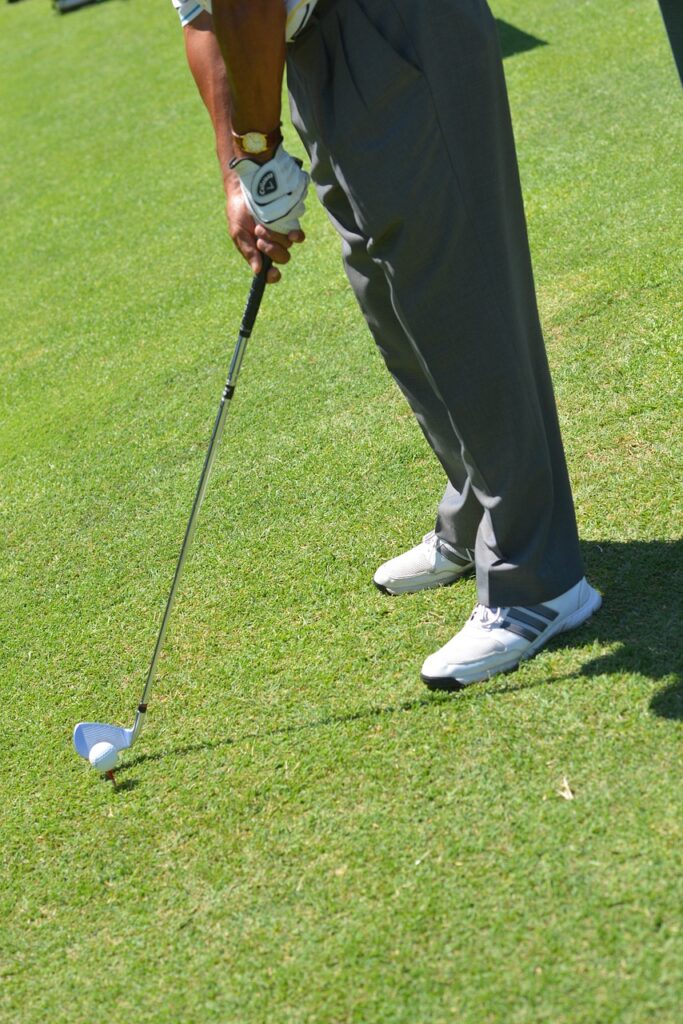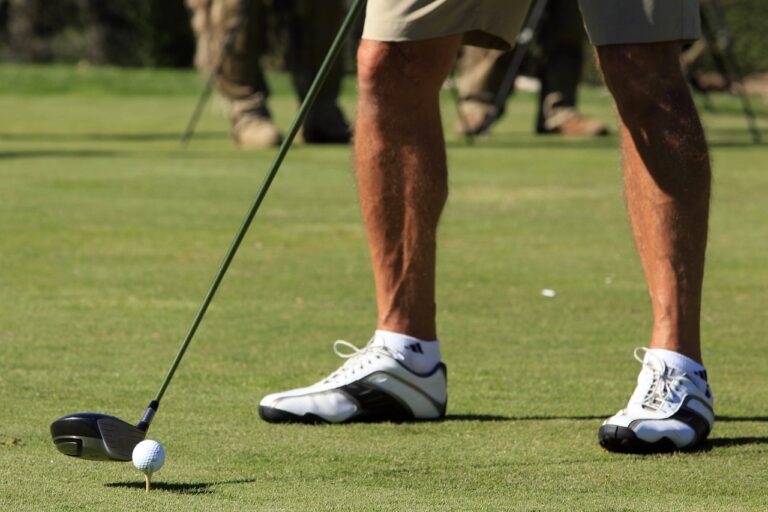How to Hit a Golf Ball
If you are new to golf or want to improve your game, one of the most essential skills you need to master is how to hit a golf ball. Hitting a golf ball properly can help you achieve more accuracy, distance, and consistency in your shots, as well as reduce the risk of injury and frustration.
How to Hit a Golf Ball – Steps By Steps Guide.
Here is a guide through the main steps and techniques involved in hitting a golf ball, as well as some common challenges and mistakes that beginners face and how to avoid them.
Step 1: Set Up Your Swing.

The first step in hitting a golf ball is to set up your swing correctly. This involves holding the club, standing, and positioning yourself in a way that allows for optimal power, control, and alignment.
Hold the club with a secure, natural grip
Your grip is your only physical connection to the club and through that, the ball. Therefore, it is important to hold the club with a secure, natural grip that allows for control and flexibility.
For a neutral grip, which is a good starting point for most golfers, place your non-dominant hand (the one closer to the target) towards the top of the club, so your palm is about a half an inch from the end of the club. Place your dominant hand (the one farther from the target) just below your non-dominant hand.
Keep the club in the creases between your palms and fingers instead of in the middle of your palms. For your dominant hand, your ring and pinky fingers should grip the club with the most pressure.
For your non-dominant hand, your index finger should make contact with the most pressure. Your grip should be loose but well-controlled. Grip the club tightly enough to keep it secure in your hands, but keep your hands free of tension.
Try to keep your hands about a fist or fist and a half away from your thighs.
Stand with your feet shoulder-width apart and knees slightly bent

Your stance is the foundation of your swing. It provides stability, balance, and mobility for your entire body. To achieve a proper stance, stand with your feet shoulder-width apart and knees slightly bent.
Your non-dominant foot should be in front, or closer to the target. Position your back foot perpendicular to the target line (the imaginary line that connects the ball and the target), and point your front toe slightly toward the target. This can allow for increased hip rotation during your swing.
Distribute your weight evenly on each foot, and keep your weight on the balls of your feet.
Bend forward from your hips and square your body with the ball and the target
The final part of setting up your swing is to bend forward from your hips and square your body with the ball and the target. Bending forward from your hips allows you to create a diagonal angle between your spine and the ground, which enables a full shoulder and hip turn on your backswing.
To find the correct angle, imagine a clock face; the angle between 12 o’clock and 3 o’clock is 90 degrees. To bend at the correct angle, your back should be just past 1 o’clock, or around the 6 minute mark. You can check yourself in a mirror or ask someone to watch you to gauge the angle of your hip bend.
Squaring your body with the ball and the target means aligning your shoulders, hips, knees, and feet parallel to the target line. Imagine you are standing on train tracks. Your feet should be on one rail, and the ball should be on the other.
Step 2: Perform a Basic Swing

Once you have set up your swing correctly, you are ready to perform a basic swing. A basic swing consists of four phases: backswing, downswing, impact, and follow-through. Each phase requires coordination, timing, and rhythm.
Shift your weight back and rotate your hips, torso, shoulders, and arms
The backswing is the phase where you prepare to hit the ball by moving the club away from it. To start your backswing, gradually shift your weight to your back foot while keeping both feet planted on the ground. Just before you start rotating, rotate your body, your arms, shoulders, and hips in a smooth, continuous motion
To continue your backswing, rotate your body, your arms, shoulders, and hips in a smooth, continuous motion. Your arms should swing back in a straight line until they reach about chest level, then bend slightly at the elbows.
Your shoulders should turn about 90 degrees, or until your non-dominant shoulder is pointing at the ball. Your hips should turn about 45 degrees, or until your back pocket is facing the target. Your head should remain still and your eyes should stay on the ball throughout the backswing.
Swing down and hit the ball first, then the turf

The downswing is the phase where you swing the club down towards the ball and make contact with it. To start your downswing, shift your weight back to your front foot and initiate the movement with your hips.
Your hips should rotate towards the target before your shoulders and arms. This creates a lag effect that generates more power and speed for your swing. As you swing down, keep your arms and wrists relaxed and let the club follow the natural arc of your swing.
Your goal is to hit the ball first, then the turf, with a slight downward angle of attack. This will create a solid contact and a crisp sound.
Follow through with your swing by extending your arms and rotating your body toward the target
The follow-through is the phase where you complete your swing after hitting the ball. To follow through with your swing, extend your arms and rotate your body towards the target.
Your club should finish over your non-dominant shoulder, pointing at the target. Your non-dominant foot should remain on the ground, while your back foot should lift up slightly on its toe. Your chest should face the target, and your head should follow the flight of the ball.
Step 3: Make Adjustments for Different Shots
Once you have mastered the basic swing, you can learn how to make adjustments for different types of shots that golfers can use depending on the situation. Some of the common types of shots are drives, irons, wedges, chips, and putts.
Each type of shot requires different adjustments in your stance, grip, ball position, club selection, and swing speed.
Drives.
Drives are long-distance shots that are usually played from the tee box. The aim of a drive is to hit the ball as far as possible while keeping it on the fairway (the section of the golf course with short grass between the tee and green).
To hit a good drive, you need to use a driver (the longest and least lofted club in your bag), widen your stance slightly beyond shoulder-width apart, move the ball forward in your stance so it is opposite your front heel, tilt your body slightly away from the target to create more room for your swing, and swing with more speed and force than other shots.
Irons
Irons are medium-distance shots that are usually played from the fairway or rough (the section of the golf course with longer grass). The aim of an iron shot is to hit the ball high and land it softly on or near the green (the section of the golf course where you will find the hole).
To hit a good iron shot, you need to use an iron (a club with a flat face and varying degrees of loft), narrow your stance slightly to shoulder-width apart or less, move the ball back in your stance so it is in line with your chest or sternum, keep your body level with the target to create a steeper angle of attack, and swing with a smooth and controlled tempo.
Wedges.
Wedges are short-distance shots that are usually played from the fairway, rough, or sand (the section of the golf course with bunkers or pits filled with sand). The aim of a wedge shot is to hit the ball high and stop it quickly on the green.
To hit a good wedge shot, you need to use a wedge (a club with a high loft and a grooved face), narrow your stance even more to less than shoulder-width apart, move the ball back in your stance so it is in line with your back foot or slightly forward, lean your body slightly towards the target to create more spin and control, and swing with a short and crisp motion.
Chips
Chips are very short-distance shots that are usually played from near the green. The aim of a chip shot is to hit the ball low and roll it towards the hole.
To hit a good chip shot, you need to use a wedge or a low-lofted iron, narrow your stance to the minimum, move the ball back in your stance so it is behind your back foot, lean your body and hands forward to create a low trajectory, and swing with a gentle and steady motion.
Putts

Putts are the final shots that are usually played on the green. The aim of a putt is to roll the ball into the hole.
To hit a good putt, you need to use a putter (a club with a flat face and no loft), stand with your feet close together and parallel to the target line, position the ball slightly forward in your stance so it is under your eyes, keep your body and head still and your eyes on the ball, and swing with a pendulum-like motion using only your shoulders and arms.
Conclusion
We have covered the main steps and techniques involved in hitting a golf ball, as well as some common challenges and mistakes that beginners face and how to avoid them. By following these tips and practicing regularly, you can improve your golf game and have more fun on the course.







